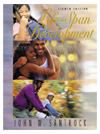 |  Life-Span Development, 8/e John W. Santrock,
University of Texas - Dallas
Infancy Socioemotional Development in Infancy
Chapter ObjectivesI.Understand the difficulty of defining emotion and the complexity of its components. |
 |  |  | II.Describe the use of MAX in determining a developmental timetable of emotions. |
 |  |  | III.Discuss how crying, smiling, and stranger anxiety are important communication mechanisms for infants. |
 |  |  | IV.Explain the concept of temperament, including the types of temperament, goodness of fit, and the implications of temperamental variations for parenting. |
 |  |  | V.Discuss early personality development, including trust and the developing sense of self and independence. |
 |  |  | VI.Define attachment, then describe the importance of the research of Harlow and Zimmerman and the theories of Erik Erikson and John Bowlby. |
 |  |  | VII.Describe the types of attachment and the Strange Situation, being sure to mention what behaviors manifest themselves for each type and what caregiving styles will predict each type. |
 |  |  | VIII.Discuss criticisms of attachment theory and the Strange Situation laboratory procedure, understanding the role played by cultural differences. |
 |  |  | IX.Understand reciprocal socialization and scaffolding, and the notion of the family as a system. |
 |  |  | X.Describe the roles of the mother and the father in the development of an infant. |
 |  |  | XI.Indicate the effects of day care on developmental processes in infancy and what constitutes high-quality day care for infants. |
|



 2002 McGraw-Hill Higher Education
2002 McGraw-Hill Higher Education